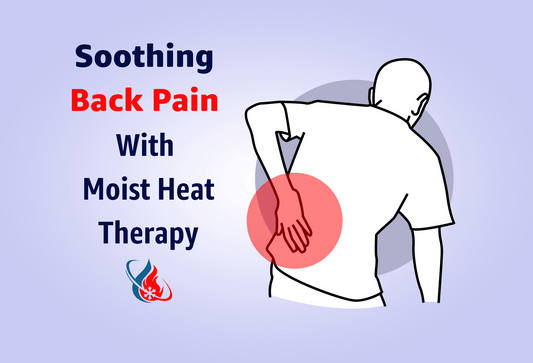Heat Therapy Tips to Relieve Hip Pain
"You're trying to get the opposite effect of what's going on. If you're physically swollen, you want to try and cool that area down to allow you to have less pain. If you're not physically swollen, then you're trying to heat it up to increase blood flow to help with the healing process." ~ Dr. Brett Smith, DO
Hip pain can range from very mild discomfort to highly distressing physical pain that can make simple everyday tasks difficult and often reduce the overall quality of life. Hip pain is most common in older adults. Studies show that this type of pain is higher in women than men. Researchers determined that the participants included in one study recorded that 7% of women were diagnosed with symptomatic hip arthritis as opposed to 5% of men living with the same diagnosis.

What Causes Hip Pain?
Hip pain is typically caused by damage or issues in the hip's cartilage, joints, and/or bones. These problems tend to worsen with age as bones weaken and we become more susceptible to falls. Hip pain could originate from:
- Fracturing the hip due to falling or other injuries
- Arthritis/Osteoarthritis
- Labral hip tear
- Joint or bone infection
- Strained hamstring
- Iliotibial band syndrome
- Bursitis
- Osteonecrosis
- Femoral acetabular impingement
- Groin injury/strain
- Snapping hip syndrome
- Tendinitis

Heating vs. Cold for Pain Relief
Medical recommendations to relieve pain vary between cold and heat therapy. There are a few tips to help determine the appropriate temperature when it comes to pain in the hip area.
- If your hip pain directly results from an injury, a cold compress must be applied first. Cold therapy can numb the pain, slow down bleeding and reduce inflammation & swelling.
- If your hip pain lasts longer than two days or results from a chronic medical condition, it is suggested to use warm compresses to reduce stiffness and ease pain once the inflammation has subsided. Medical professionals recommend that moist heat can improve hip issues that cause long-term pain. A Rheumatologist from Blount Memorial Physicians Group in Tennessee stated.
"You're trying to get the opposite effect of what's going on. If you're physically swollen, you want to try and cool that area down to allow you to have less pain. If you're not physically swollen, then you're trying to heat it up to increase blood flow to help with the healing process." ~ Dr. Brett Smith, DO

Types of Heat Therapy
When we hear the term Cold Therapy it is commonly understood that it mainly refers to using cold packs, frozen vegetables, or bags of ice to relieve inflammation and swelling. However, when moist Heat Therapy is necessary for pain relief, what resources can be used at home?

- Heating Pads - Microwavable heating pads are the most efficient way to provide heat therapy at home. For example, Harti creates hand-crafted microwavable heating pads using natural ingredients and fibers. Naturally sourced, these heating pads are filled with 100% locally grown oats that radiate moist heat. Every heating pad is designed with two layers of 100% plant-based cotton fabric and individually hand-sewn for quality & durability. They are shipped in 100% Eco-Friendly packaging and are made (with love) in Ontario, Canada.
- Hot Bath, Sauna, or Hot Tub – This moist heat creates a feeling of comfort, reducing anxiety and pain.
- Steam Shower – Both heat and pressure from shower water massaging the affected area can calm muscle spasms, loosen joints, and soothe the pain.
- Car Seat Warmer - When driving, turn on your vehicle car seat warmer (if it has one) for a great way to source heat directly to your hip area when you’re on the go.
Stay Active
If your hip pain results from an injury, you should rest and seek medical attention. However, if you have chronic hip pain, experts say exercise is the most critical path to recovery. Hip-targeted exercises can loosen tight joints and relax any excess tension in the hip flexors & muscles surrounding the hips.
 The adage "You don't use it, and you lose it" stands true regarding physical health. Long periods of inactivity can tighten the hips. Any exercise like walking, swimming, physical therapy, yoga, stretching, pilates, etc. that is targeted to benefit the hip area can help reduce pain and help in many ways:
The adage "You don't use it, and you lose it" stands true regarding physical health. Long periods of inactivity can tighten the hips. Any exercise like walking, swimming, physical therapy, yoga, stretching, pilates, etc. that is targeted to benefit the hip area can help reduce pain and help in many ways:
- Strengthens muscles in the surrounding area
- Stabilizes the range of motion in the hips
- Reduces the risk of damaging the hips
- Decreases the chance of surgeries
- Encourages pain relief
When to Call a doctor
Sometimes it can be challenging to determine when it’s time to call for help when we experience medical symptoms. You should seek medical attention immediately if you notice
- Sudden swelling with warmth in the affected area
- Joint pain accompanied by fever or skin rash
- Joint pain that becomes debilitating
- Hip pain that continues for longer than six weeks
- Hip pain following other unusual symptoms
Have you had success in relieving hip pain using microwavable heating pads? What type of heat therapy works best for you?







